Many iconic guitarists own many different instruments over the course of their career, and many—like Stevie Ray Vaughan, who called his most cherished six-string his "First Wife"—develop a deep love for that one special guitar. Whether it's a well-aged acoustic or a banged-up electric or an axe assembled from bits of this and pieces of that, some guitars just have that certain je ne sais quoi that makes them as famous as their owners.
From the international theft of George Harrison's "Lucy" to the raging inferno that birthed B.B. King's "Lucille," there are guitars that are forever linked to the musicians who loved them. The following are the stories behind nine of the most celebrated guitars in music history.
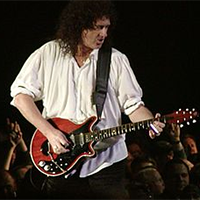
One of the most renowned guitars in the history of rock music is Brian May's "Red Special," also referred to as "The Fireplace" or "The Old Lady." Custom-built by May and his father Harold in 1963 over a two-year period, it is the guitar that would go on to define Brian's unmistakable playing style and sound with Queen.
May, who at the age of 16 couldn't afford a guitar, built his Red Special from an 18th century fireplace mantel that a friend of the family was about to throw away. The hand-shaped neck, which was difficult to work with due to the age and quality of the wood, was finished with a 24 fret oak fingerboard. According to May, there are two wormholes in it.
Brian also made use of household items to construct his guitar, such as a filed down piece of his mother's knitting needle for a whammy bar and position inlays that were shaped from a mother-of-pearl button. May personalized his inlays with two dots at the 7th and 19th frets and three at the 12th and 24th frets. The name Red Special was inspired by the reddish-brown color the guitar acquired after being stained and painted with numerous layers of Rustin's plastic coating.
"I designed the instrument from scratch," Brian says, "with the intention that it would have a capability beyond anything that was out there, more tunable, with a greater range of pitches and sounds, with a better tremolo, and with a capability of feeding back through the air in a 'good' way, i.e. in a self-sustaining mode." May has used his Red Special through all of his years in Queen, in both live performance and studio work.
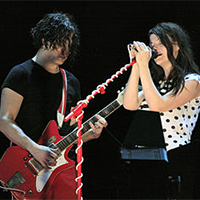
Always one to pay close attention to the visual aspect of his music, Jack White adopted a red, white and black color scheme for his band, The White Stripes—from their album art to the clothes he and bandmate Meg wore on stage to the instruments they played. White is also known for his simplistic, raw approach to the composition, arrangement and performance of his music. You can imagine then Jack's delight when a friend first opened his guitar case and introduced him to the Airline guitar. To hear Jack tell it, his reaction was something along the lines of, "Oh, man! That's amazing! That's......my color! And it's plastic. I love it so much!" White bought the used red guitar on the spot for a couple hundred dollars, broken neck pickup and all.
The hollow, fiberglass Airline guitar was a brand of electric and acoustic guitars made in the United States from 1958-68 by the Valco Manufacturing Company and sold at low prices through the Montgomery Ward catalog. The angular red Airline model played by Jack White is commonly referred to as the "JB Hutto" model, after the bluesman and slide guitar artist J. B. Hutto. Hutto was the first most visible guitarist to regularly use the Airline in live performances and recordings, and is pictured with the guitar on his Slidewinder and Stompin' at Mother Blues albums.
White's unique Airline, one of the three main guitars he used with the White Stripes, fit so well in the band that it almost seemed custom-made. He chose it, he says, to prove that you don't need a brand new guitar for your music to have character and tone and to be able to play what you want to play.
"It's work to play it," White says, "but I like that. If I wanted to play it safe I'd go out and get a brand new Stratocaster or something like that. But I don't like to play it safe; I like it when things get messed up. It's like when things get messed up onstage: it forces me to figure something out now, because no one else can save me. With a guitar like the Airline, my mind is always working. I'm not just phoning it in."
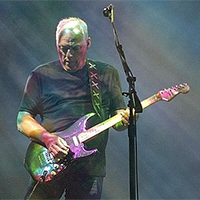
David Gilmour is one of the world's most revered guitarists, and his black Fender Stratocaster is almost as legendary and the man himself. Gilmour's Black Strat was featured on Pink Floyd tours and has been integral to the sound of the band's fabled albums including Meddle, Atom Heart Mother, Obscured By Clouds, The Dark Side Of The Moon, Wish You Were Here, Animals and The Wall. It was also used on David's solo projects About Face and On an Island.
When Pink Floyd toured the US in 1970, Gilmour brought only his white Stratocaster along. After landing in New York City in early April, he bought a new 1969 black Stratocaster with a rosewood neck and white pickguard at an instrument shop called Manny's Music. The guitar was used in several of the Floyd shows that followed. Sadly, the band's equipment was stolen in May in New Orleans, and although most of it was recovered, both David's white and the new black rosewood Strats were lost. Floyd was forced to cancel the rest of their shows.
Gilmour returned to Manny's on the band's way back to the UK and purchased a new black 1969 Fender Stratocaster to replace the stolen one, this one with a maple neck. (The guitar was originally sunburst but had been repainted black.) The Black Strat made its debut at England's Bath Festival in June 1970. It was to become David's main guitar for the next 15 years.
The Black Strat underwent many changes over the years with different necks, pickups and custom features and Gilmour switching out the white pickguard with a new black one. By the mid '80s, David had replaced all of his guitars with Fender's new line of 1957 reissues. He donated the Black Strat to the Hard Rock Café in Dallas where it was on display until 1997, when David requested it back. The Black Strat made its triumphant return in 2005 for the reunion of Pink Floyd at the Live 8 show in London's Hyde Park. It's been David's main guitar ever since.
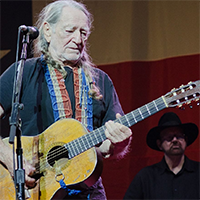
Willie Nelson has been playing a Martin N-20 nylon-string acoustic guitar he named "Trigger" for more than 40 years. A classical guitar designed with no pickguard, Nelson bought the famous relic, named after Roy Rogers' horse, without even seeing it.
The Baldwin company had originally given him an amp and classical electric guitar with a special three-cord stereo pickup, which became his main guitar, but during a show in Helotes, Texas, Nelson left the guitar on the stage floor where it was later stepped on by a drunk man. Willie sent the instrument to country musician and guitar designer and manufacturer Shot Jackson in Nashville to see if it could be repaired.
Shot called Willie back with bad news: The guitar was too badly damaged and couldn't be fixed. So Willie asked what else Jackson had around. Shot said he had a Martin up on the shelf for $750. Willie asked if he could put that same Baldwin pickup in the Martin, and when Shot said he could, Willie bought the guitar sight unseen.
Willie said he knew he had gotten something special when he first laid hands on Trigger. He liked the sound of it. He enjoyed sitting around in a room, playing the new guitar and writing on it. In his book, The Tao of Willie: A Guide to Happiness in Your Heart, Nelson says Trigger is a part of him.
Nelson's road worn guitar is one of the most instantly recognizable instruments in existence. Willie's constant strumming with a guitar pick over the decades has worn a large sweeping hole into the body near the bridge, and the front of the guitar is covered with over a hundred names, signatures of those close to Nelson including Leon Russell, Roger Miller, Kris Kristofferson, Gene Autry, Johnny Cash, Waylon Jennings, lawyers, football coaches, and other friends and associates.
In 1991, during his ordeal with the IRS, Nelson was worried that his favorite guitar would be auctioned off. He always said that when Trigger goes, he'd quit making music. Willie asked his daughter, Lana, to take the guitar from the studio before any IRS agent got there and bring it to him on Maui. Nelson then hid the guitar in his manager's house until his debt was paid in 1993.
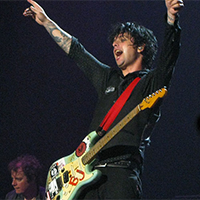
Green Day's Billie Joe Armstrong brings a mixed bag of new and old guitars with him out on tour. The majority of them are Gibson Les Paul Jr. models, but Billie's main guitar squeeze is a stickered Fernandes Stratocaster called "Blue," which dates back to the early-'80s.
When he was eleven years old, Billie acquired Blue from local guitar teacher George Cole. Armstrong looked up to Cole and greatly admired his teacher's powder-blue Stratocaster, a copy of Jimi Hendrix's preferred Fender Stratocaster. The young Billie Joe imaginatively nicknamed the guitar Blue.
Billie's mother noticed how much her son talked about Blue, and she managed to scrape together the three or four hundred dollars to buy the guitar from Cole. It sparked an interest in the budding musician, and Billie played the life out of that guitar. He used Blue for years until it was held together by little more than duct tape and desire.
Armstrong used Blue primarily on Green Day's earlier stuff like "Basket Case," "Longview," "Brain Stew," and "Hitchin' a Ride." He later had Fender make him replicas of the guitar, which he played live and mostly gave away after shows. Armstrong still uses reproductions of Blue on stage, complete with its duct tape and stickers.
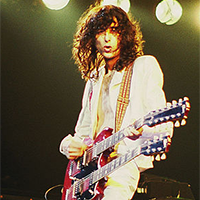
Although all his guitars look pretty darn iconic, the unforgettable guitar that made the multi-sectioned "Stairway to Heaven" a certifiable epic is Jimmy Page's Double Neck Gibson. A twelve-string on top and a six-string on the bottom, this guitar rewrote rock 'n' roll history in the hands of Page and spawned plenty of imitators.
The Double Neck Gibson eliminated the need to switch guitars mid-song. During live performances of "Stairway," Page would alternate from the bottom 6-string for the delicate fingerpicking of the song's intro, verses and legendary solo, to the ringing 12-string for the song's era-defining bridge and final chorus. Page also used the instrument for other Zeppelin classics, such as "The Song Remains the Same" and "The Rain Song."
While Page remains as the artist most closely associated with this striking guitar, a host of other legendary guitarists have played it live and have incorporated the EDS-1275 into their own cache of guitars, including Slash, James Hetfield, jazz legend John McLaughlin, Rush's Alex Lifeson, Eddie Van Halen, and Elton John's Davey Johnstone. But it was Page's historic performances of "Stairway" that made this guitar one of the most famous ever.
The Double Neck Gibson is never sold in huge numbers, but remains in production by various custom shops that want to keep its legend alive.
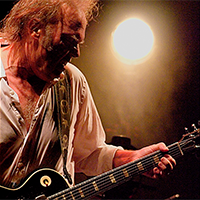
Neil Young's treasured guitar, "Old Black," has been with him for over forty years. He acquired the guitar in 1969 through a trade with one-time Buffalo Springfield collaborator Jim Messina, who received one of Young's orange Gretsch guitars (Gretsch 6120 Chet Atkins) in exchange.
Old Black began life as a Gibson Les Paul Goldtop, the only finish available when the Les Paul models first went into production in 1952. The guitar acquired its name, however, from its distinctive jet black spray paint job, thought to have happened after the instrument was left at a guitar repair store.
Most of Young's electric guitar parts have been recorded on Old Black, and it has rarely been seen without Neil's famous peace symbol and dove guitar strap. Few musicians show quite this much dedication to a single instrument throughout their career. Not even back pain from the weight of the guitar can deter Neil from playing it.
According to Young's guitar tech, Larry Cragg, Old Black has been a real headache. It frequently goes out of tune and Young refuses to re-fret the fingerboard, but when the stars align, he says, Old Black can still produce one of the most distinct sounds in the music industry. This beat-up old beauty is one of the most loved and used guitars in rock 'n' roll, still making albums and touring to this day.
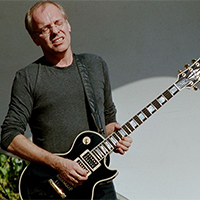
The story of Peter Frampton's guitar of choice begins in 1970 when Frampton and his old band Humble Pie scored a gig playing two sets a night at the Fillmore West in San Francisco. Frampton says the first night was a rough go. The guitar he was using fed back at loud volumes and made soloing a chore. After the show, an audience member approached him and offered his own modified Les Paul for Peter to try at the following night's performance. Frampton accepted and the arrangement was love at first strum. As he told weekends on All Things Considered host Guy Raz, "For both sets, I don't think my feet touched the ground the whole time. I mean, I levitated."
That guitar—a shiny black number with an added pickup—became Frampton's signature instrument. He continued to use it with Humble Pie and in his solo material, and played it almost exclusively for years. It even made the cover of his classic 1976 live album, Frampton Comes Alive!
Then in 1980, while Frampton was on tour in South America, the guitar was put on a cargo plane in Venezuela, en route to Panama. The plane crashed right after takeoff, and Peter's guitar was presumed destroyed along with the rest of the band's gear.
What Frampton didn't know was that the guitar had survived, albeit with some bumps and bruises. It fell into the hands of a musician on the Caribbean island of Curaçao, who owned it for many years before a local guitar collector spotted it and contacted Frampton. After two-years of negotiation, the guitar was returned to Frampton in December 2011, over three decades after it was lost. Although the guitar was a little worse for wear, Peter limited his repairs, doing only what needed to be done to make the instrument playable again. He says he prefers his guitar with its battle scars.

Another legendary guitarist with a stable of renowned guitars is Eric Clapton. Out of the literally thousands of guitars he has owned though, one holds a special place in his heart—"Blackie."
"I get seriously attached to an instrument," Clapton said in an interview with Guitar Center. "A guitar like Blackie comes along maybe once in a lifetime. I played it for twelve years non-stop on the road, and it's still got it. The action is perfect even though the neck is quite worn down and narrow. All you've got to do is pick it up and it sort of plays itself. I developed a lot of trust and security with that instrument."
Slowhand's old faithful companion was actually built from the best parts of different 1950s Strats. As the story goes, Clapton bought several Stratocasters in the early '70s from a guitar shop in Nashville, Tennessee. He gave three away to friends George Harrison, Pete Townshend, and Steve Winwood, and then took the best components from the remaining four guitars to build Blackie. (Eric Clapton's first Stratocaster was a brown burst that he called "Brownie." After that, it only made sense to call the black one that came next "Blackie.")
Blackie's debut came in January 1973, on stage at the Rainbow Concert in London. For the next twelve years it remained Clapton's main guitar until he retired it from action after his 1985 world tour. He brought the guitar out for a handful of special occasions after that, including his 1991 Royal Albert Hall shows.
In 2004 Eric decided to sell his beloved companion at a Christie's auction to help raise funds for his Crossroads Centre, a treatment and rehabilitation clinic for chemically dependent and compulsively addicted persons located in Antigua. Contributing nearly a million dollars to Clapton's cause, Guitar Center walked away with Blackie.
Zakk Wylde's "Bullseye," Tom Morello's "Arm the Homeless" Custom, ” Tony Iommi's "Old Boy" SG, Keith Richards' "Micawber" Fender Telecaster, Eddie Van Halen's "Frankenstrat,"—the list goes on and on, each cherished guitar with its own unique story to tell. What guitars would you add to the list and why? Let us know in the comments.